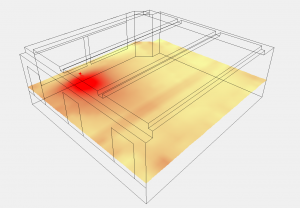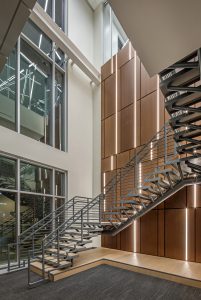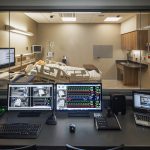What is an Acoustical Consultant?
You step into the room, feeling your way along the rough wall, searching for the light switch. You can hear something that sounds like it is in the room with you, a steady thump…thump…thump. You know it is not your own heart, it sounds mechanical. Between each beat, you hear the low voices threatening…to hire an acoustical consultant.
What is an Acoustical Consultant?
There are few things more distracting than a space filled with background noise from the echoes of voices to the sounds of machinery that keep a building running. Fortunately, acoustical consultants are specialists in acoustical engineering and can provide solutions for a variety of issues.
Ultimately, an acoustical consultant provides recommendations to improve the acoustical qualities (including noise level, sound isolation, room acoustics, or vibration) of a space to the client (who may be an architect, building owner, building tenant, mechanical engineer, or resident). Spaces in need of treatment can include existing rooms, new construction, renovation projects, or environmental areas.

Computer model of a room with acoustical treatments.
It might not seem possible to be able to anticipate how a room will sound, but acoustical designers do not base their calculations on imagination or assumption. Rather, acousticians use tools such as auralizations. Auralizations are audio files that allow a person to hear how a space will react to sound and, in the case of acoustical design, enable an individual to “hear” the difference certain acoustical treatments will make to a room. When paired with a virtual reality headset, a person can take a tour of a room that has not even been built yet, experiencing what that space will look and sound like when complete.
Performance spaces and musical venues are the most obvious clients who would benefit from these demonstrations; however, they can be just as helpful for public spaces. Picture a hallway full of people carrying on casual conversations; it might sound something like this:
Using computer modeling (in this example, a program called Odeon) an acoustical consultant can demonstrate to the building owner how different acoustical treatments could improve the space, including minimal acoustical treatments:
or full acoustical treatments:
How Can You Tell There is a Problem?
The area of acoustics is very subjective, with every person having a preferred noise level to live, work, and play. Anyone can tell if a space is too noisy or echoes uncomfortably, like in the situation described in the opening paragraph, with the sounds of mechanical equipment and background conversation.

Computer model of actual sound levels of the training room at 1201 Cass Street using a program called Odeon.
For this reason, an acoustical consultant looks more toward the purpose of a specific room when providing acoustical engineering services. As Jessica Hiatt, CTS-D, an acoustical engineer and project manager at IP Design Group says, “Nobody notices acoustics unless they’re bad. We try to provide acoustic environments that promote the use of the space, as well as blend into the aesthetic of the room.” For instance, in a music hall, sound should carry so that everyone can enjoy the concert whether they are sitting in the front row or the back.
According to Hiatt, there are many strategies and programs that can be used to detect, diagnose, and solve acoustical problems. Hiatt and her team often use computer models to build a digital environment that reflects the physical environment they are working in. Examples of some of these modeling programs include EASE (for room acoustical modeling), AIM (for mechanical noise modeling), and INSUL (for sound isolation modeling, which addresses sound transmission). The computer model then allows the team to evaluate how sound is currently traveling throughout the space and decide what angles or surfaces need to change in order to achieve the sound standards required by the space as defined by its intended purpose.

Front atrium at 1201 Cass Street.
In a building that has not been built yet, this can save the owner time and money by proactively resolving some acoustical issues that would otherwise have to be addressed later in construction or in renovations. However, some acoustical issues cannot be prevented, especially in the case of unique architecture. In this case, the IP Design Group acoustical team will travel to the project location to take onsite measurements of background noise, sound transmission, reverberation time, and/or intelligibility.
These measurements can then be put into a computer model that will be manipulated by the team, allowing them to design creative solutions. In the case of IP Design Group’s new headquarters at 1201 Cass Street, the building’s front atrium is a statement piece that naturally reflects sound because of its hard surfaces and high ceiling. To bring noise down to a more comfortable level, Hiatt and her team designed a wall of wooden panels that both reduce reverberation and provide an artistic focal point to welcome visitors.
Can I Really Hear a Difference?
There are a variety of benefits to hiring an acoustical consultant that lead to an enhanced user experience beyond simply lessening background noise. Sound masking supports better speech privacy, a benefit valued by businesses that manage sensitive projects and aim to preserve client confidentiality. This is especially important as commercial office spaces trend toward a more open-concept design.
Good speech intelligibility, on the other hand, leads to increased understanding. This is especially important in educational spaces where studies have shown that well-designed acoustics promote better learning from preschoolers to university students. Examples of how acoustics impact K-12 learning are featured in School Planning & Management Magazine’s article, “Acoustical Considerations for 21st-Century K-12 Learning Environments.”
One of the greatest benefits to hiring an acoustical consultant is the cost savings. An acoustical consultant’s role is to help prevent excess noise, vibration, and reverberation from taking away from the space. When acoustic treatment options can be analyzed before construction, an acoustical consultant can determine if and where cost is justified. Oftentimes, the best cost savings occur when acoustical issues can be identified early because solutions are usually easier to find and less expensive to implement.
In fact, a client can not only save money by hiring an acoustical consultant early in the design process, but the acoustics of a given space can also be tailored during design to better support the desired function of the space. A space being used for speech, such as a classroom, needs to have less sound reflecting back so that the speaker’s words are heard clearly.
Tailoring design is clearly showcased in the training room at IP Design Group’s headquarters. Below, a computer model created through Odeon, displays how the sound (emanating from the source represented by the red dot in the graphic to the right) bounces most prominently off the back wall. To lessen the impact of the sound reflection, the acoustical team tailored the space to include specialized projection screens. These allow the sound to travel through the screens and be absorbed by the insulation installed behind, resulting in better speech intelligibility.
It is these kinds of considerations that enable occupants of a space to truly appreciate the value an acoustical consultant has brought to a project, even if the appreciation is subconscious.
Where Can I Learn More?
To learn more about the acoustical consulting services that Jessica and her team provide at IP Design Group, visit their services page.
For a more basic breakdown of noise control, visit the Institute of Noise Control Engineering of the USA (INCE-USA)’s website.
The National Council of Acoustical Consultants (NCAC) is an organization that is committed to supporting the acoustical profession through educational opportunities, as well as being a resource for the public to connect with acoustical consultants.










